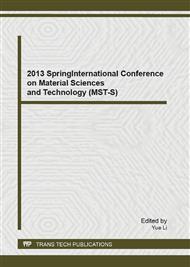p.241
p.246
p.252
p.258
p.264
p.270
p.275
p.281
p.289
A High-Performance Bimetallic Pd-Cu Nanoparticles Membrane on Glassy Carbon Electrode for Formic Acid Oxidation
Abstract:
The Palladium-copper nanoparticles (PdCu NPs) have been prepared by potentiostatic electrodeposition from a mixture electrolyte of H2PdCl4 and CuSO4,then placed the electrode in sulfuric acid using cyclic voltammetry sweep a few laps to fabricate the PdCu NPs/glass carbon electrode (Pd-Cu/GCE). The modified electrode electrochemical properties of a preliminary study found that this modified electrode has good stability and electrochemical activity, experiments show that formic aicd has good voltammetric response of the electrode. The electrical activity of the formic acid in the Pd/GCE is lower than that in the Pd-Cu/GCE, this is due to the synergistic effect of the bimetal. When the Cu content is increased gradually in H2PdCl4 and CuSO4 a mixed solution, the formic acid oxidation peak currentlower, because Cu has no electrocatalytic activity for formic acid oxidation.
Info:
Periodical:
Pages:
264-269
Citation:
Online since:
June 2013
Authors:
Keywords:
Price:
Сopyright:
© 2013 Trans Tech Publications Ltd. All Rights Reserved
Share:
Citation:


